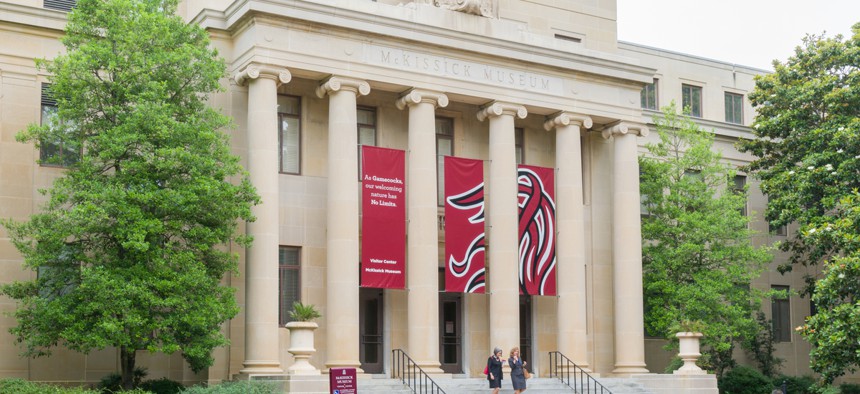The Economic Driver Next Door: Universities

University of South Carolina has expanded economic development opportunities in the last several years. Ken Wolter
COMMENTARY | Instead of placing big bets on projects like Amazon HQ2, state and local governments should look to institutions like universities to usher in economic productivity.
As postings for senior Amazon positions began appearing on Northern Virginia job boards this summer, I was reminded that just a short time ago the nation held its breath as more than two hundred cities and states offered bids to secure what had been touted as the largest economic development trophy of our time: Amazon’s second headquarters.
Human psychology primes us to see marquee projects like HQ2 as the pinnacle of economic development. Big-name corporate partners capture people’s imagination, with promises of new jobs and state-of-the-art campuses that will revitalize long-stagnant neighborhoods, practically overnight. However, perspective can be easily lost in all this excitement. For every region like the Washington D.C. metro area that secures an HQ2-like award, there are hundreds of other places that thrive off lower-profile, but no less important, economic anchors.
Traditional community pillars like universities, hospitals and military bases quietly support prosperity across the United States. Many of these institutions have been the backbone of their communities for decades, employing thousands of residents, generating revenue for local businesses and funneling resources back into the local economy. While often viewed as the end recipients of government funding, the best of these institutions serve as force multipliers of public resources.
Outside of their primary purpose to educate, heal or protect, these American anchor institutions deserve more credit for the significant economic impact they generate. Few people considered the impact of nearby military installations prior to the initiation of Base Realignment and Closure proceedings under President Ronald Reagan. And community hospital centers have long struggled to achieve recognition for the services they provide despite heavy workloads and minimal personnel resources.
This dilemma was top of mind in 2013 when after years of sluggish economic recovery in my home state of South Carolina, allocation of state funds to universities was increasingly scrutinized. Lost in this scrutiny was that institutions that build human capital firm up local economies all over the country. Universities, for example, are the largest job creators in 66 of the 100 largest U.S. cities. Part of the reason that these figures do not regularly make headlines is that they have been regarded as gospel for generations of economic developers. Through the thought leadership of University of South Carolina’s (UofSC) former president, Dr. Harris Pastides, we proactively confronted this challenge. The result was the creation of the Office of Economic Engagement, which was tasked with expanding UofSC’s economic development potential by fostering relationships with the private sector.
Historically, cultural differences between academics and executives have long stood in the way of establishing mutually-beneficial collaborations, but those barriers are falling away because of forward-thinking organizations on both sides. Operating on an annual budget of just $1.4 million, our team at UofSC found new ways to pair all-star faculty with business leaders in adjacent fields by leveraging already well-known work on advanced manufacturing and aviation. Companies such as Boeing, IBM and Siemens saw the advantages of further integrating their R&D and recruitment programs with South Carolina’s flagship university. All in all, UofSC’s efforts turned a $1.4 million investment into more than $790 million in direct economic impact for the local economy in the form of hundreds of new jobs, grants from the federal government and industry and partner investments.
Marquee projects like an HQ2 deserve their moment in the spotlight, but traditional anchors present a far more common and consistent asset for economic development in cities and states across America. When undertaking the difficult yet critical task of allocating public funds, policymakers and elected officials would do well to keep that in mind. Thanks to the leadership of Gov. Henry McMaster and the general assembly, South Carolina recognizes that fact, having just made the largest reinvestment of public funds in higher education in more than a decade. Like a large ship on the open ocean, economic prosperity rarely turns on a dime. But when it comes to crafting lasting economic progress, it is the very stability of these institutions that can augment the “next big thing” and help usher in the sustainable economies of the future.
Bill Kirkland is executive director of the University of South Carolina’s Office of Economic Engagement. He is a former CEO of a software company and corporate executive.
NEXT STORY: In a Booming State, Lawmakers Face a Looming Transportation Cut





